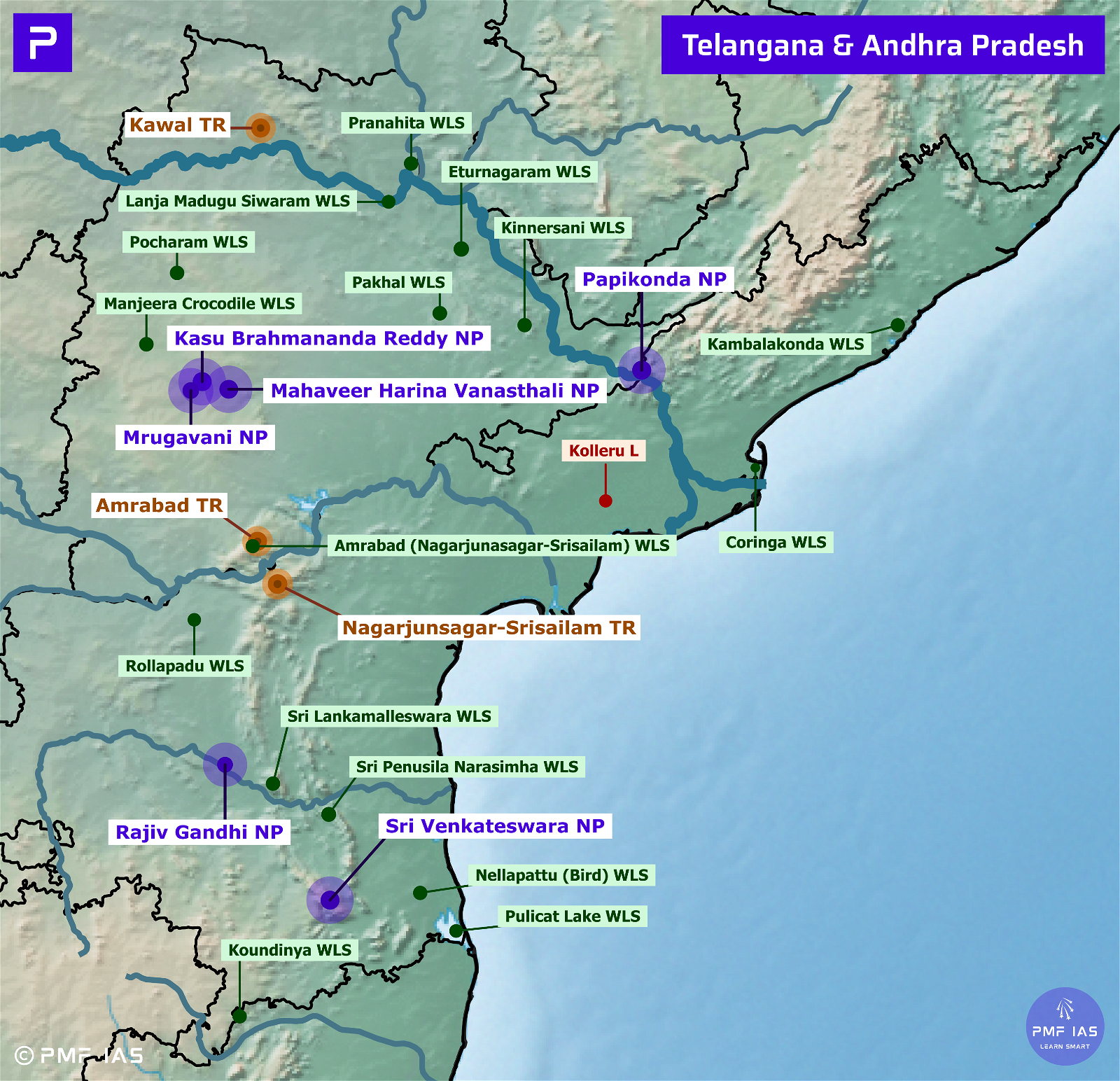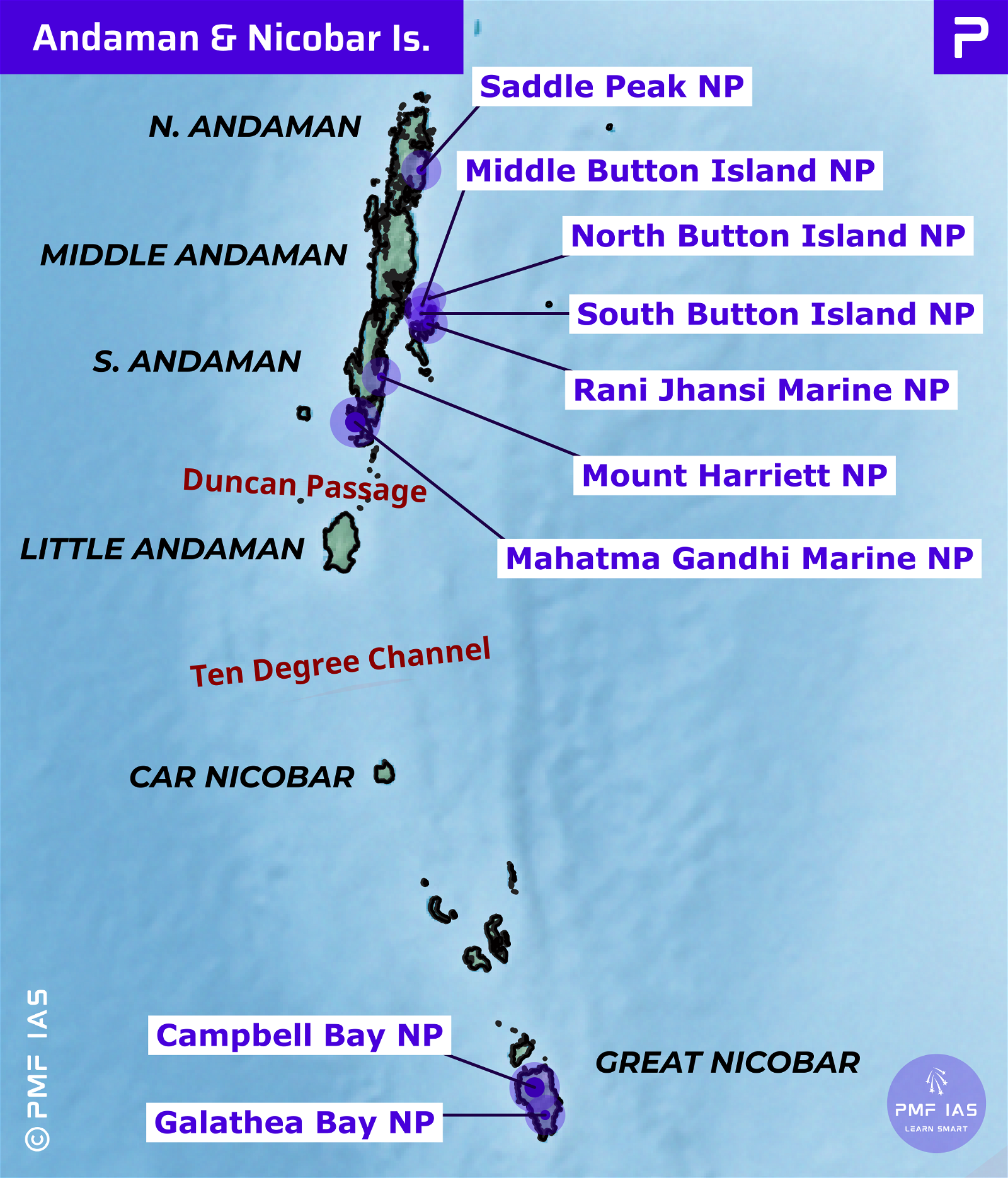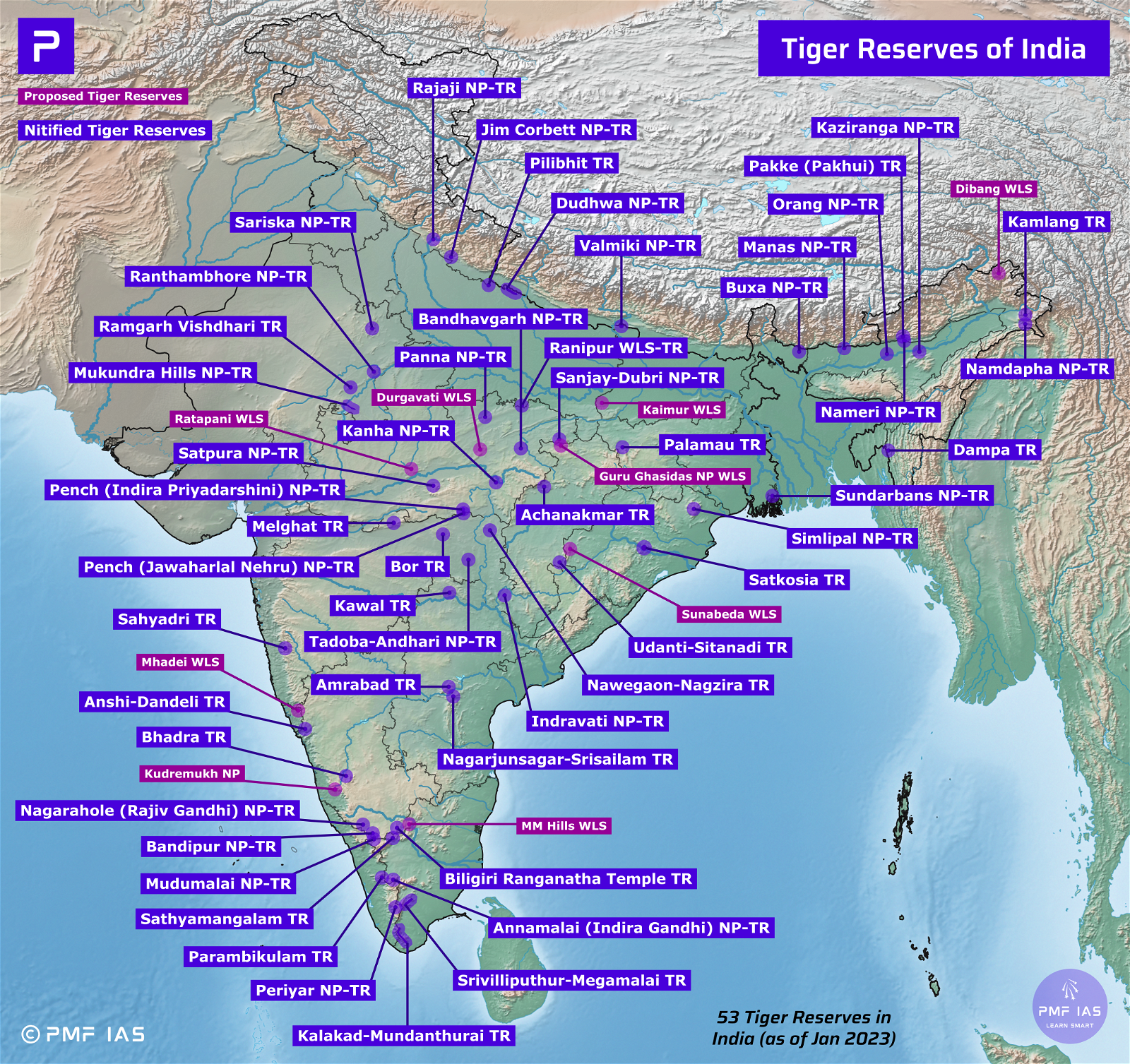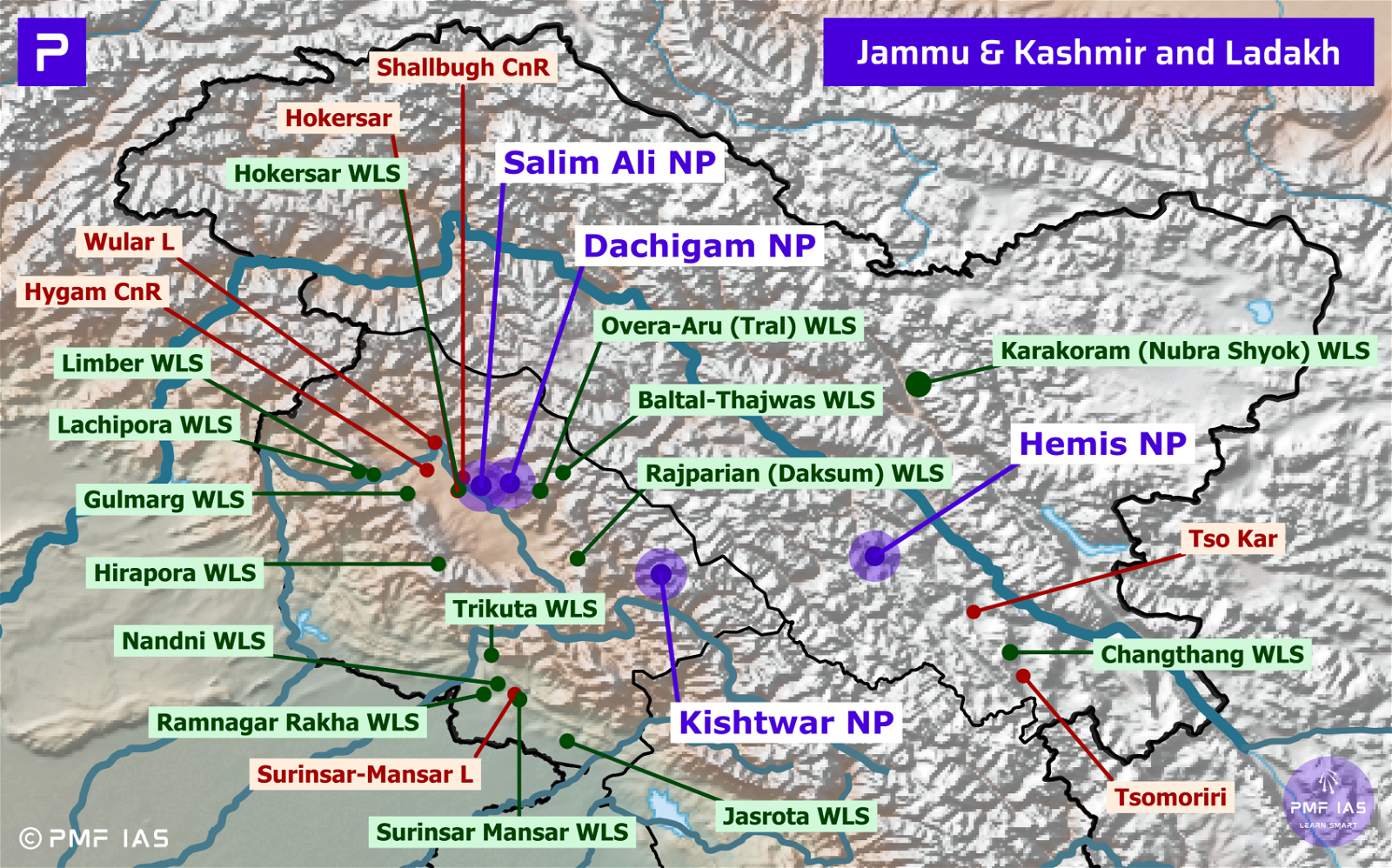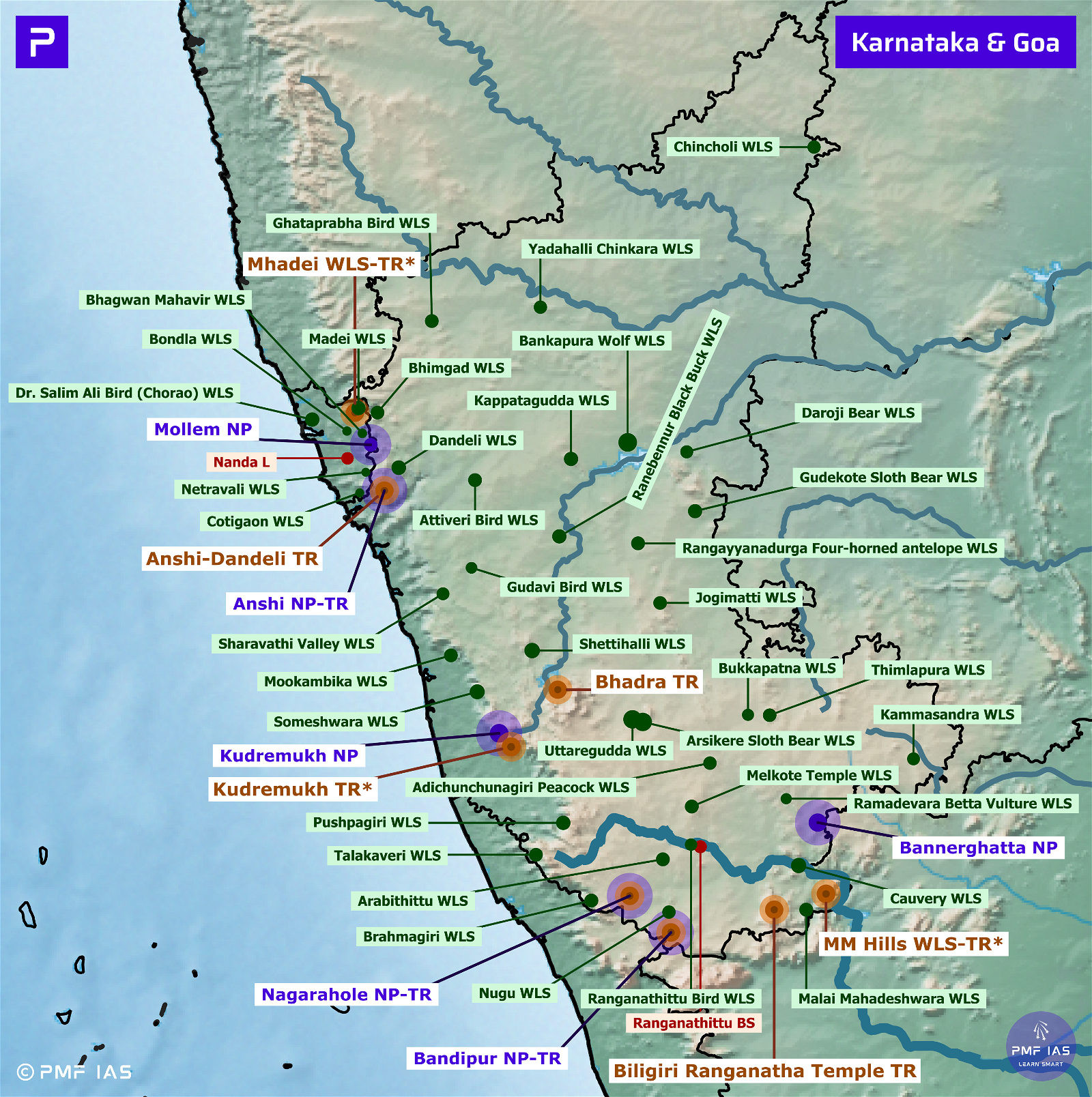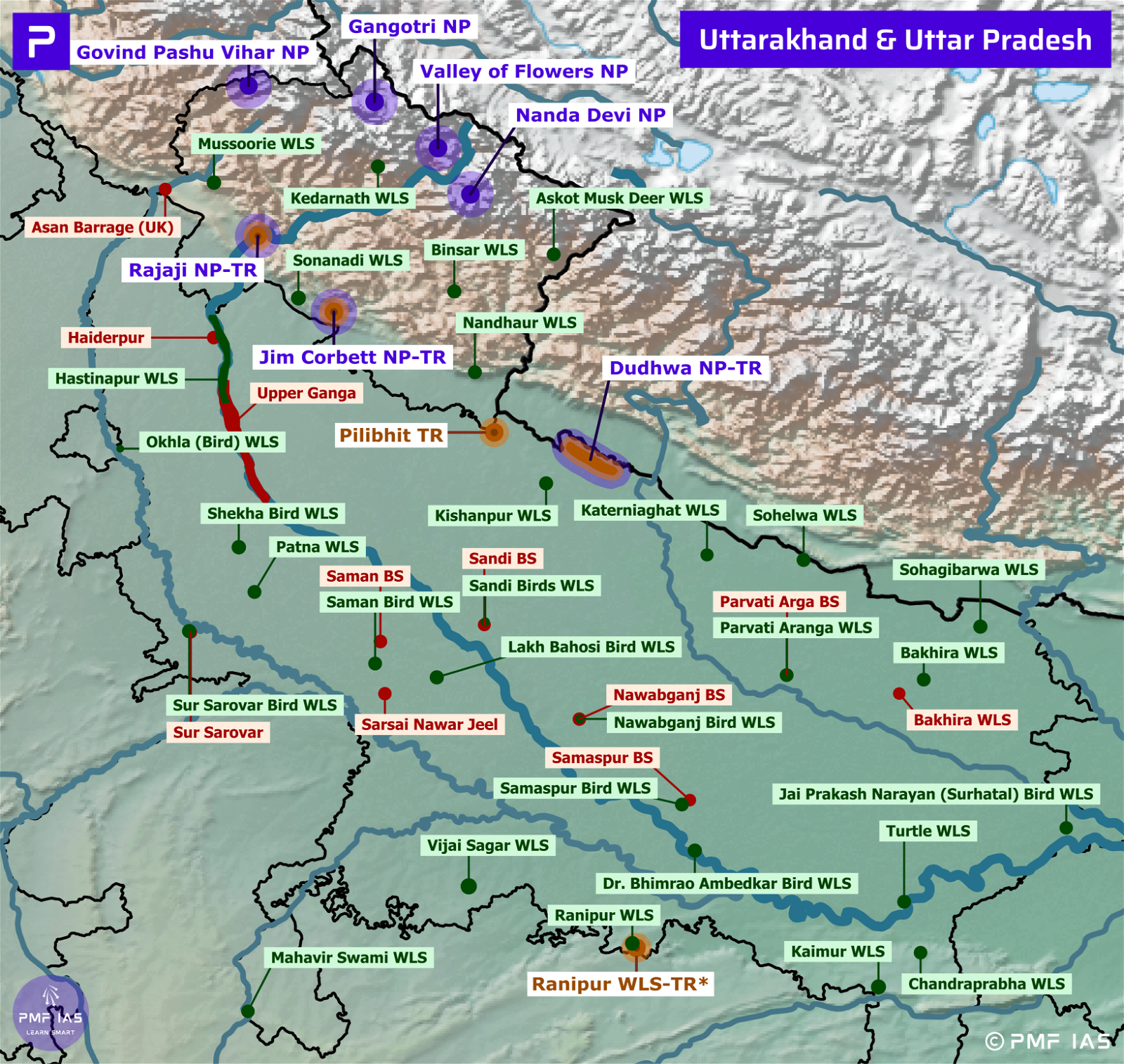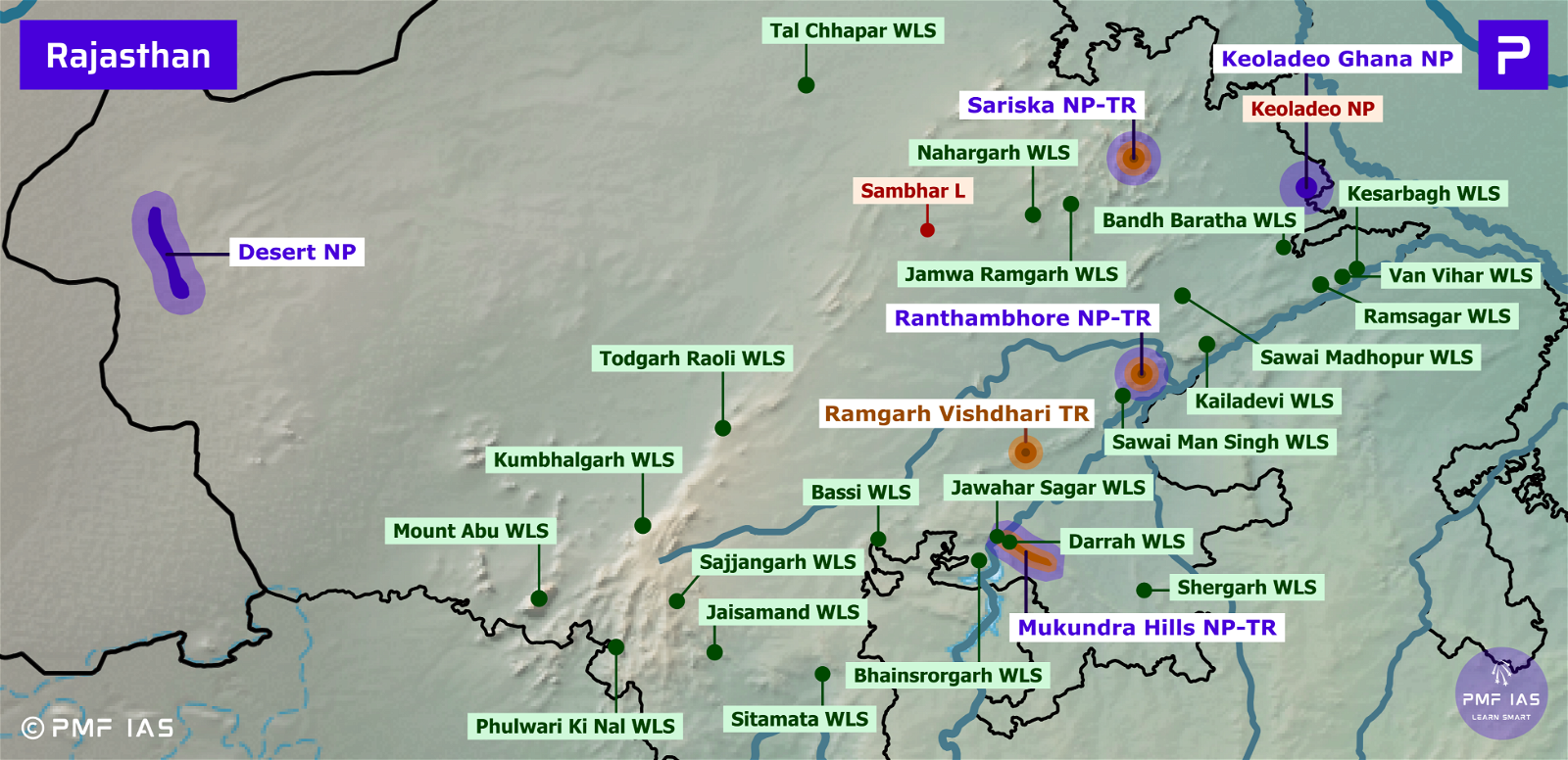
Maharashtra National Parks, Tiger Reserves, Wildlife Sanctuaries & Ramsar Sites
Subscribe to Never Miss an Important Update! Assured Discounts on New Products!
Must Join PMF IAS Telegram Channel & PMF IAS History Telegram Channel
Last updated on April 19, 2024 12:41 PM
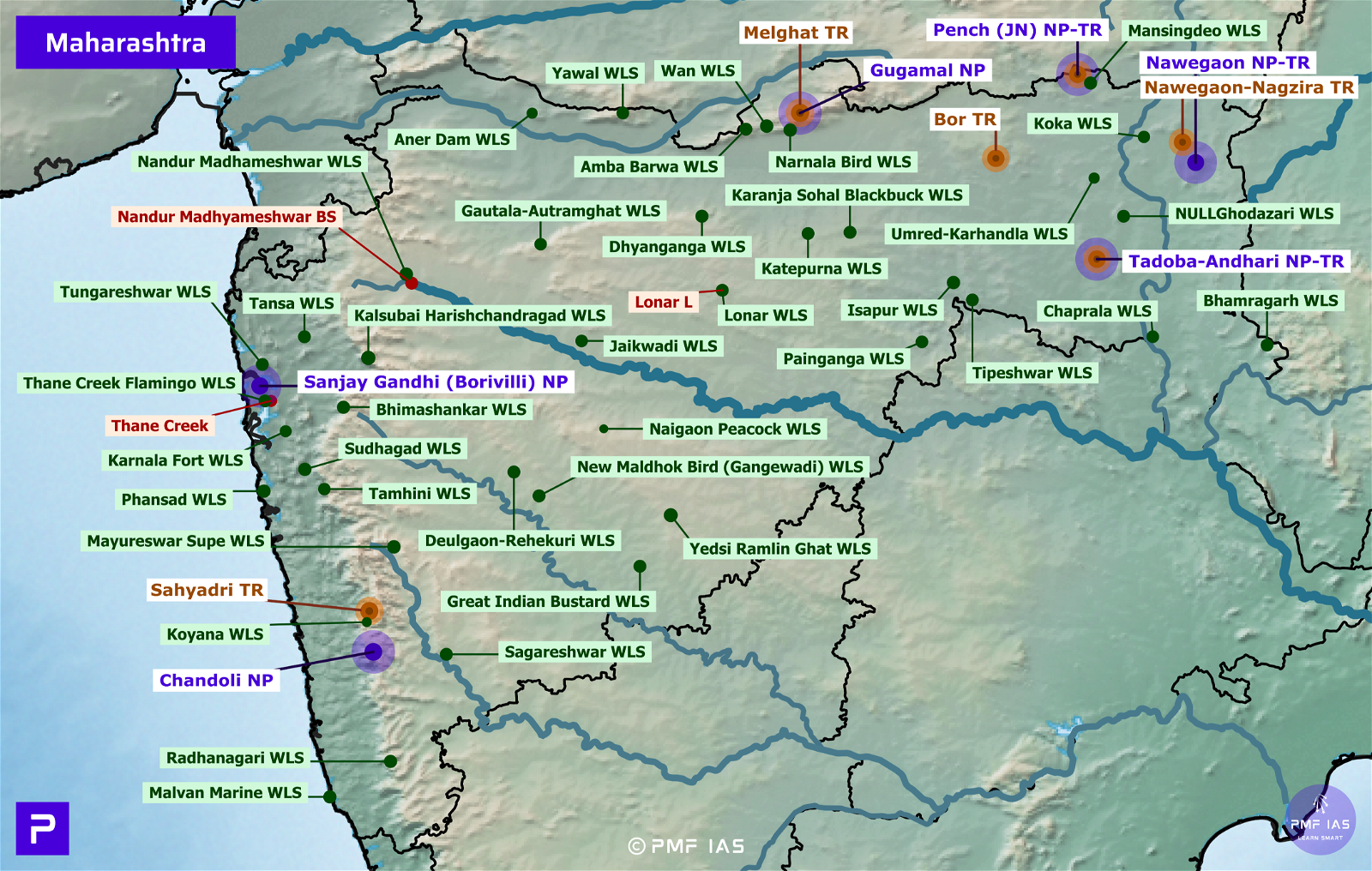
Bor Tiger Reserve, Wildlife Sanctuary
- It includes the drainage basin of the Bor Dam.
- Vegetation: Dry deciduous forests.
- Major Flora: Teak, tendu and bamboo.
- Major Fauna: Bengal tiger, Indian leopard, Indian bison, blue bull, chital, barking deer, mouse deer.
- Threats: Forest fires and human-animal conflict.
Melghat Tiger Reserve, Gugamal National Park
- It is located in the Amravati region. Tapi River and Gawilgarh Hills (of Satpura Range) form its northern boundary.
- Gugamal National Park is part of Melghat Tiger Reserve. It is one of seven protected areas in the Melghat Tiger Reserve.
- The Tiger Reserve is a catchment of five major rivers: Khandu, Khapra, Sipna, Gadga and Dolar (all tributaries of Tapti).
- Vegetation: Dry deciduous forest.
- Major Fauna: tiger, leopard, sloth bear, chausingha, gaur, barking deer, nilgai, rhesus monkey.
Nawegaon National Park
- Dr Salim Ali Bird Sanctuary, Navegaon is home to almost 60% of bird species found in entire Maharashtra. Every winter, flocks of migratory birds visit Nawegaon lake.
- Vegetation: Moist and dry deciduous forest.
- Major Fauna: Tiger, leopard, Indian gaur, sloth bear, common giant flying squirrel, small Indian civet.
- Navegaon Nagzira Tiger Reserve = Nawegaon National Park + Nagzira Wildlife Sanctuary + Koka Wildlife Sanctuary.
Jawaharlal Nehru Pench National Park, Tiger Reserve
- Pench Tiger Reserve straddles across Madhya Pradesh and Maharashtra. It comprises the Indira Priyadarshini Pench National Park (MP) and the Jawahar Nehru Pench National Park (Maharashtra).
- Vegetation: tropical dry deciduous forest.
- Major Flora: Teak, segun, tendu.
- Major Fauna: Royal Bengal tiger, leopard, sloth bear, gaur, four-horned antelope.
Chandoli National Park, Sahyadri Tiger Reserve, Koyna Wildlife Sanctuary
- Sahyadri Tiger Reserve = Chandoli National Park + Koyna Wildlife Sanctuary.
- It is located in Sahyadri Range of the Western Ghats.
- Koyna Wildlife Sanctuary has two reservoirs along the Koyna River, Shivsagar Lake and Koyna Reservoir.
- Vegetation: Moist deciduous forests.
- Major Fauna: Tiger, leopard, gaur, sloth bear, giant squirrel, barking deer, sambar, mouse deer, blackbuck.
Sanjay Gandhi (Borivilli) National Park
- It is located in Mumbai. 2400-year-old Kanheri caves sculpted out of a massive basalt lie within the park. It served for the Buddhist centres of education.
- Major Flora: Kadamba, tea.
- Major Fauna: Chital, rhesus macaque, Indian muntjac, Asian palm civet, mouse deer, Indian flying fox, leopard.
Tadoba Andhari Tiger Reserve, Tadoba National Park, Andheri Wildlife Sanctuary
- It is Maharashtra’s oldest and largest National Park. Tadoba Lake and Erai Reservoir are the major wetlands in the reserve. Erai reservoir offers a good habitat for mugger crocodile (marsh crocodile).
- Tadoba Andhari Tiger Reserve = Tadoba National Park + Andhari Wildlife Sanctuary
- Vegetation: Dry deciduous forest.
- Major Flora: Teak, tendu.
- Major Fauna: tiger, gaur, nilgai, dhole, small Indian civet.
- Threats: Human habitations and forest fires.
Wildlife Sanctuaries of Maharashtra
Amba Barwa Wildlife Sanctuary
- It is located to the west of Melghat Wildlife Sanctuary.
- Melghat Tiger Reserve = Gugamal National Park + Melghat Wildlife Sanctuary, Narnala Wildlife Sanctuary & Amba Barwa Wildlife Sanctuary.
Andhari Wildlife Sanctuary
- Tadoba Tiger Reserve = Tadoba National Park + Andhari Wildlife Sanctuary
Aner Dam Wildlife Sanctuary
- It is situated on southwestern range of Satpura range. It is contiguous with the Yawal Wildlife Sanctuary.
Bhamragarh Wildlife Sanctuary
- It is located in the Vidarbha region. Parlkota River (tributary of Indravati River) flows through it. It is contiguous with the Indravati Tiger Reserve (Chhattisgarh).
Bhimashankar Wildlife Sanctuary
- It surrounds Bhimashankar Temple in the Sahyadris. It was created to protect the habitat of Indian (Malabar) Giant Squirrel (LC), the state animal of Maharashtra.
- Bhimashankar Temple is popular Jyotirlinga shrine in Maharashtra (others are Trimbakeshwar, Nashik & Grishneshwar, Aurangabad). Bhimashankar is the source of the Bhima River (a tributary of Krishna River).
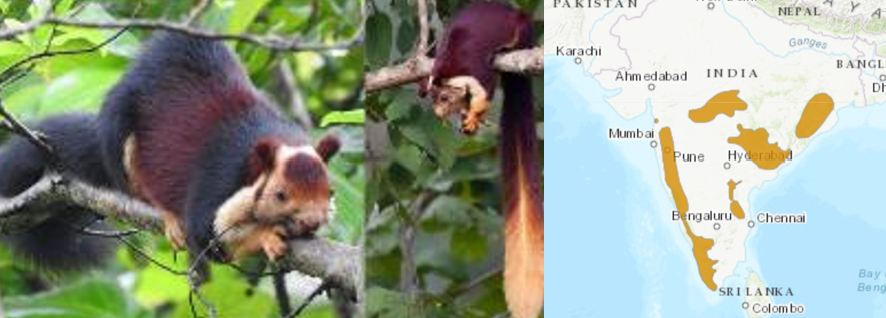
Chaprala Wildlife Sanctuary
- Pranhita River (formed by the confluence of Wardha & Wainganga Rivers) flows along its western boundary.
- The Wildlife Sanctuary serves as a link between the Tadoba Tiger Reserve (Maharashtra) and the Indravati Tiger Reserve (Chhattisgarh).
Deulgaon-Rehekuri Wildlife Sanctuary
- It is situated in Ahmednagar district. It was declared a Wildlife Sanctuary tp protect Blackbuck (LC), locally known as ‘Kalvit’.
Dhyanganga Wildlife Sanctuary
- It about to the southwest of Melghat Tiger Reserve. Dhyanganga River, a minor tributary of the Purna River, which itself is a tributary of the Tapti River, flows through the Wildlife Sanctuary.
New Maldhok Bird (Gangewadi) Wildlife Sanctuary
- Gangewadi grassland, located on the boundary of Solapur and Osmanabad districts, is now notified and included in the Great Indian Bustard Sanctuary in Solapur district.
Gautala-Autramghat Wildlife Sanctuary
- It lies in the Satmala and Ajantha Hill ranges of the Western Ghats. It is located to the west of Ajanta Caves.
Ghodazari Wildlife Sanctuary
- Loacted in Vidarbha region, it is a tiger corridor that connects Tadoba-Andhari Tiger Reserve with Umred Karhandala Wildlife Sanctuary.
Great Indian Bustard Wildlife Sanctuary
- Also known as Jawaharlal Nehru Bustard Sanctuary), it is a Wildlife Sanctuary for the Great Indian Bustard (CR).
- The land is drought-prone and semi-arid.
Isapur Wildlife Sanctuary
- It is located in the Yavatmal district.
- Painganga River (rises in the Ajantha range; a tributary of Wardha River) flows through the Isapur Wildlife Sanctuary.
Jaikwadi Wildlife Sanctuary (BS)
- It sprawls across the backwaters of Nath Sagar reservoir (Jaikwadi Dam) constructed over Godavari River.
- Nath Sagar reservoir is a multipurpose project used to irrigate drought-prone Marathwada Region.
Kalsubai Harishchandragad Wildlife Sanctuary
- It is located in the Sahyadris (Western Ghats).
- The Wildlife Sanctuary surrounds the Kalsubai peak (1646 m), the highest point of Maharashtra.
Karnala Fort Wildlife Sanctuary (BS)
- It is located between Mumbai and Lonavala Hill Station.
Karanja Sohal Blackbuck Wildlife Sanctuary
- It was created to preserve the blackbuck (LC) population.
Katepurna Wildlife Sanctuary
- It is located in the Vidarbha region.
- It is renowned for the four-horned antelope (chausingha, VU) and barking deer (Indian muntjac, LC).
Kolamarka Wildlife Sanctuary
- It is a Conservation Reserve in Gadchiroli upgraded to Wildlife Sanctuary in 2022.
Koyna Wildlife Sanctuary
- It is an Important Bird Area located in the Western Ghats.
- Sahyadri Tiger Reserve is lies between Koyna Wildlife Sanctuary and Chandoli National Park.
- It forms the catchment area for the Koyna River, and Shivsagar reservoir formed by the Koyna Dam (the major portion of the Shivsagar reservoir or Shivajisagar Lake and the Koyna Dam lie in the Sahyadri Tiger Reserve).
Lonar Wildlife Sanctuary (Ramsar Site)
- It is a saline alkaline lake (pH value more than 7) located in Buldhana district. It is a 56,000-year-old crater created by a meteor impact during the Pleistocene Epoch (2.58 million to 11,700 years ago).
Malvan Marine Wildlife Sanctuary
- The core zone includes the Sindhudurg fort (built by Chhatrapati Shivaji Maharaj). The fort occupies an islet near the coastal town of Malvan.
Mansingdeo Wildlife Sanctuary
- On the Maharashtra side, the Mansinghdeo Wildlife Sanctuary acts as a buffer zone of Pench Tiger Reserve.
Muktai Bhawani Wildlife Sanctuary
- A Conservation Reserve upgraded to Wildlife Sanctuary in 2022.
Nandur Madhameshwar Wildlife Sanctuary (BS) (Ramsar Site)
- It is located in Nashik at the confluence of the Godavari and Kadwa Rivers. It is Maharashtra’s first Ramsar site.
Narnala Bird Wildlife Sanctuary
- It is located in the Gawilgarh Hills (in Vidarbha) along with the Melghat Tiger Reserve. Both the Narnala fort and the Gawilgarh Fort are located in the Gawilgarh Hills
Painganga Wildlife Sanctuary
- It is flanked by river Painganga or Penganaga River on the three sides. Penganaga River rises in the Ajantha range and is a major tributary of the Wardha River.
Phansad Wildlife Sanctuary
- It is located in Raigad district. It was created to preserve coastal woodland ecosystem of the Western Ghats.
Radhanagari Wildlife Sanctuary
- It lies at the southern end of the Sahyadri hills in the Western Ghats. It is the first declared Wildlife Sanctuary in Maharashtra.
- Indian bison or gaur (VU) is its flagship species .

Sagareshwar Wildlife Sanctuary
- It is located to the east of Chandoli National Park in Sangli district (lies outside Western Ghats). It is a man-made forest.
Sudhagad Wildlife Sanctuary
- It surrounds the Sudhagad Fort located in the Western Ghats. It lies between Lonavla hill station and Raigad Fort. Thanale Buddhist caves (of 1st century B.C.) lie close to it.
Thane Creek Flamingo Wildlife Sanctuary
- It is an inlet with mangroves that isolates Mumbai from the mainland. It is Maharashtra’s second marine sanctuary after Malvan sanctuary.
Tipeshwar Wildlife Sanctuary
- It is an isolated Wildlife Sanctuary with tiger presence in Pandarkawada district. Penganga River flows along its periphery.
Umred-Kharngla Wildlife Sanctuary
- It is a tiger corridor that connects Tadoba-Andhari Tiger Reserve with Nagzira Tiger Reserve. It is bounded by the Wainganga River on east.
Others
- Koka Wildlife Sanctuary: Between Wainganga River and Nagzira Wildlife Sanctuary.
- Yedsi Ramlin Ghat Wildlife Sanctuary: Osmanabad district.
- Mayureswar Supe Wildlife Sanctuary: Located in Pune district.
- Naigaon Peacock Wildlife Sanctuary: Located in Beed district.
- Tamhini Wildlife Sanctuary: along the Mulshi Dam adjacent to the Sudhagad Fort.
- Tansa Lake Wildlife Sanctuary: Located between Mumbai and Nashik.
- Tungareshwar Wildlife Sanctuary: Vasai Creek separates it from Sanjay Gandhi National Park (Mumbai).
- Wan Wildlife Sanctuary: A part of Melghat Tiger Reserve in Amravati district.
- Yawal Wildlife Sanctuary: Located in the Satpura Range to the west of Melghat Tiger Reserve.
Ramsar Sites of Maharashtra (3)
Lonar Lake
- It is an endorheic (closed basin) crater lake formed by a meteorite impact. It is high in salinity and alkalinity due to the lack of an outflow.
- Specialized micro-organisms such as anaerobes, cyanobacteria and phytoplankton survive in this harsh chemical environment. Recently, the colour of Lonar lake water had turned pink due to a large presence of the salt-loving haloarchaea microbes.
- Haloarchaea or halophilic archaea is a bacteria culture that produces pink pigment and is found in water saturated with salt.
Nandur Madhameshwar
- Construction of the Nandur Madhameshwar Weir at the confluence of the Godavari and Kadwa Rivers helped create this thriving wetland.
- The site hosts leopards and Indian Sandalwood (VU).
- Species: Deolali Minnow Fish (CR), Indian Vulture (CR), White-Rumped Vulture (CR)
Thane Creek (Flamingo Sanctuary and IBA)
- It is one of the largest creeks of Asia. It is fringed by mangroves on both banks. It falls under the Marine Ecoregions of the World (MEOW) but is fed by numerous freshwater sources, making the water brackish. Ulhas River is the largest source of freshwater.
The MEOW biogeographic classification system divides the coastal, nearshore, and shelf areas of the world into ecoregions. Each ecoregion is ecologically distinct from the others.
Last updated on April 19, 2024 12:41 PM






